Editor’s note: All of us who work with archives are, one way or another, paleographers. Whether we are deciphering the historical abbreviations in a sixteenth century manuscript, the intimate communications of a nineteenth century letter, or the messy labels on an old tape cassette, our work is mediated through the hands of the people who came before.
Formal training for colonial Latin American paleography can be difficult to access. Pterodáctilo is pleased to be able to share this lucid introduction to deciphering colonial handwriting by guest contributor Nathan J. Gordon. The article, which was first presented at the joint conference for the Society of Textual Studies and the Association for Documentary Editing in 2015, is a clear and, in our opinion, essential introduction to the historical contours of paleographic work. A list of references and resources is appended. The article is written in the company of two blog posts: Six Tricks for Reading Colonial Manuscripts and Esta firma es la original.
Introduction
If you are reading this article, it is likely that you are contemplating transcribing a Spanish colonial manuscript, you have already begun the procedure, or you would like to know more about the practice. Regardless of your objective and situation, you must realize that this is a highly challenging academic pursuit that requires significant amounts of time, patience, diligence, and perseverance.
As a novice, the transcription process sounds simple at first. You take a manuscript, and while you read it, you just begin typing. However, after about ten minutes and ten words have passed, reality will set in and you will realize that there are a number of potential impediments that will prevent you from completing your transcription. Candidly, for beginners, transcribing colonial texts is a daunting task, a point Manuel Romero Tallafigo, Laureano Rodríguez Liáñez, and Antonio Sánchez González make clear, “Como de difícil solución, hasta el extremo de llevarnos a una situación de desaliento y quizás frustración, es considerada muchas veces la labor de transcripción de documentos manuscritos” (103). The process can take months or years depending on the length and type of manuscript you are working with, and this is something you will need to mentally prepare yourself for beforehand.
Regrettably, there are not enough instructional and practical resources to prepare you and guide through the transcription process. This study seeks to fill in some of the gaps by establishing a taxonomy of problems in the transcription of colonial Latin American manuscripts. Taking as a point of departure my experiences transcribing large sections of the colonial chronicle Ophir de España (1644) by Fernando de Montesinos, I will identify a series of obstacles that are common to work on the vast array of colonial-era texts that remain today unedited in archives around the world. These challenges include the presence of various hands, the orthographic and linguistic variability of Spanish in the period, and the multi-lingual nature of colonial texts. I will consider as well the problems inherent in working from digital images of such documents. The ultimate goal of this informative piece is to provide novice transcribers with a starting point, so they can become aware of the challenges they will face and properly prepare themselves in advance.
Obstacle 1: Hand Variability
While handling colonial manuscripts, one of the first problematic aspects of the texts that will undoubtedly stand out is the presence of various hands. Much like modern-day handwriting, during the colonial Latin American period people were taught and wrote differently. That is to say, writing was a trained and learned institution, and while universality was the overarching goal, deviation by organization and individuals was inevitable. Writing was, just as it is today, a product of history and social formation and association. Thus, when one confronts paleography for the first time, it must be understood that scripts, as with art, passed through many phases. It was a malleable and evolving practice.
For the purposes of this article, attention will solely be placed on Latin and Spanish scripts under Spanish institutions.[1] Without venturing too far back into the past, and in order to provide a brief overview, it is worth noting that the vast majority of Latin American colonial scripts were influenced by caroline minuscule, the imperial roman handwriting established by Charlemagne at the start of the 9th century.
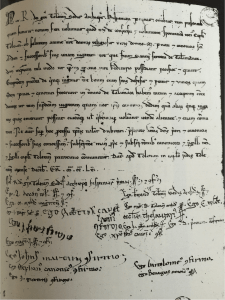
Throughout European medieval times, caroline minuscule transitioned into the gothic scripts,[2] and during the beginning of the reign of Pedro I in 1350, a variant of gothic handwriting was implemented and utilized “tanto en los documentos regios como en los privados, redondeó y estrechó sus caracteres, dando forma curva a sus rasgueos y aumentando los enlaces” (Millares Carlo 41; Romero 65). This form of cursive was proceeded by another variant of gothic scripts called cortesana, coined and enforced by Queen Isabel. It lasted through the 16th century (Millares Carlo 41).[3]
With the rebirth of Latin and the rise of humanism, both caroline and gothic scripts were followed up by a humanistic cursive many times referred to as italic. It was not so much an evolution of gothic script as it was a “littera antiqua o restauración de la unidad gráfica latina europea” (Romero 68). This latter writing reformation became widely promoted by Juan de Iciar’s Ortografía práctica in 1548 (González Antias 46). It ended up being one of the more dominant scripts utilized during the Latin American colonial period, but it too had a wide array of modifications.
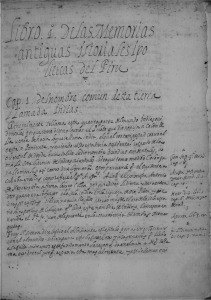
About a year ago, when I decided I was going to attempt to transcribe approximately three hundred and fifty pages of Fernando de Montesinos’s chronicle, Ophir de España, it was as though I had traveled back in time. I was quickly reminded of the first few times I had sat down and ventured to read some of the cursive letters my grandparents had sent me during my childhood. Initially, the humanistic scripts that were so carefully inked on to the colonial folios appeared as nonsensical childish doodles. However, with effort, practice, resource checking, and loads of patience, the scribbles transformed into meaningful and insightful words.
Once I had finally gained control of the handwriting from Book I of Ophir de España and was making significant progress with my transcription, I was bombarded by a second and third script. While it was the same type of humanistic script, the large and subtle dissimilarities created new obstacles. Stylistically speaking, the movement and flow changed. Angles were sharpened, frills were added, and letters were modified. All of these variants slowed my comprehension and quickness during the transcription process.
One must bear in mind that colonial manuscripts will generally include several hands. Chroniclers tended to use multiple scribes while dictating their version of history. Likewise, most colonial documents you will come in contact with were legal and clerical forms of communication that incorporated many hands by scribes, notaries, and secretaries who were charged with keeping “relación con el hecho de redactar escrituras, tomar notas o guardar secretos” (González Antias 159). The presence of various dissimilar hands will initially slow down your ability to transcribe expeditiously, and unfortunately, many North American academic institutions do not provide courses that teach individuals how to read Spanish colonial paleography.
Obstacle 2: Linguistic variability
A second obstacle with Latin American colonial manuscripts, which is heavily associated with the presence of differing scripts, is the orthographic and linguistic variability of Spanish. As ones presses through the transcription process, he or she will start to recognize a lack of uniformity and orthographic norms. The strict standardization of written Spanish did not take hold until 1741 when the Real Academia Española published its first book on orthography (v). Before this time, authors lacked guidance which created widespread inconsistencies. In what follows, I will discuss a handful of the most common examples of orthographic disorder.
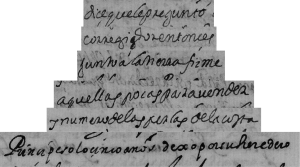
Word spacing is one of the largest issues and challenges. On a regular basis, words and phrases are meshed together with no spacing. Like unfamiliar cursive, scriptio continua slows down the contemporary transcriber’s ability to read and transcribe quickly. Colonial authors and readers relied less on word separation for textual comprehension and more so on the oral flow of syllables. Silent reading was far less common during the 16th and 17th centuries. Even the most skilled readers had the habit of reading “aloud to themselves” (Ife 8). Obviously, this antiquated writing practice makes it “difficult for [modern day] editors to decide whether spacing is intentional or an accidental reflection of the scribe’s attempt to fill a line or compress more text into it” (Mackenzie 15). Frequently, the split-second decision of whether a space is required or not is left to the transcriber.
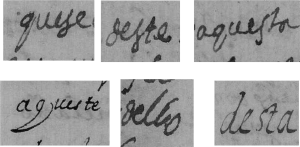
Compounds are another issue that surface in certain types of scripts like humanistic. They take place when two words are joined together to create a single long word. Many times, as the two words are grammaticalized together, they drop repeat vowels. In general, compounds have the tendency to affect the correct diction of the words (González Antias 105). Some of the frequent compounds that appear in Spanish gothic and humanistic scripts, both in print and manuscript, are dellos, destos, porquel, antel, queste, and sobrello, among others (Puche Lorenzo 44-45).
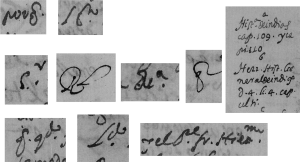
A third orthographic hurdle in colonial transcriptions is the constant usage of abbreviations. There is a large collection of abbreviations that were common to most scribes and writers; however, the symbols applied were not always universal. Their excessive inclusion, along with the particular way in which each scribe abbreviated words causes the “proceso de lectura de documentos se convierta en un trabajo al cual debe prestársele la mayor atención” (González Antias 104). A few of the most typical abbreviations are as follows: nra (nuestra), nro (nuestro), VM (Vuestra Majestad), obpo (obispo), xto (Cristo), Illmo (Ilustrísimo), q (que), qdo (cuando), and pte (parte). For the most part, abbreviations can only be learned and referenced in Spanish paleographic sources.
Other types of orthographic and linguistic variabilities novice transcribers will be confronted with are punctuation, letter variation, capitalization, and illegible words and phrases. Normalized punctuation was pretty much nonexistent. Accent marks will sometimes appear over certain letters depending on the author’s distinct style. However, there is no consistency, even with individual authors. Periods were used, but they marked “divisions which do not necessarily coincide with modern sentence divisions, and at times seem to indicate divisions between breath groups” (Mackenzie 10).
Certain letters were interchangeable, but again, this rested on the authorial tastes of the writer. For instance, when Fernando de Montesinos writes, he tends to only use the letter “u” for both “u” and “v,” but occasionally he will incorporate the letter “v”. Some exchangeable letter combinations are i/j, b/u/v, c/s, m/n, ñ/nn, and x/g. “u” and “v” can be the most difficult letters to differentiate.
Capitalization is yet another frequent inconsistency with colonial manuscripts. Sometimes words are capitalized at the beginning of the sentence or in titles as one might expect. Nevertheless, this is not always the case, and one should be aware of the fact that capitalized letters capriciously appear out of nowhere in the middle of a word causing confusing for the transcriber (González Antias 44).
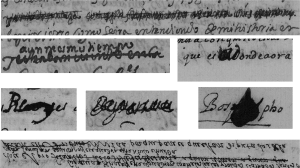
Since we are dealing with quills and ink, it should come as no surprise that occasionally words are illegible. At times, words were simply defaced, effaced, or mutilated by the author him or herself or a subsequent reader who felt the need to expunge a certain phrase, sentence, or paragraph (Mackenzie 310). Time itself is another enemy of colonial documents and words. Iron gall ink, the most popular during the 15th, 16th, and 17th centuries, included specific acids and iron ions that gradually deteriorated paper, especially when used excessively. Due to this, some colonial documents will appear sporadically burnt, making certain folios near impossible to transcribe.
Obstacle 3: Multilingualism
The multi-lingual nature of colonial texts is a third complication transcribers will be faced with. Latin, Italian, French, German and other European languages and texts were frequently included in citations. Latin is by far the most common since it was the preferred ecclesiastical language of the Roman Catholic Church, and because it reemerged and was promoted by humanists during the Spanish Renaissance period: “It developed in reaction to what the humanists considered the decadence of Medieval Latin. The humanists reacted against what in their eyes were the ahistorical and nonliterary consequences of centuries of linguistic and, therefore, cultural distortion and ignorance” (D’Amico 353). Since it was viewed as an enlightened and elitist language among scholars, its presence and practice extended to Colonial Latin America. One of several problems with transcribing additional languages is that fact that they too come with their own types of orthographic and linguistic variabilities.
Obstacle 4: Facsimiles
Finally, on a very practical level, a fourth obstacle beginning transcribers will confront is the problems inherent in working from digital images of colonial documents. While it is possible to transcribe colonial manuscripts from the original source, if one is fortunate enough to have continual access to the document’s archive, the likely scenario is that the transcriber will ultimately end up with a digital copy. How then does an individual properly view the digital images and transcribe simultaneously?
One option is to simply print the facsimiles. However, this prevents the transcriber from the option of zooming in on the manuscript and gaining a closer look at specific words or phrases, which tends to be a necessary step. Another option available is that of operating two monitors at once, whether this be with two computers or one. One monitor can be used to display the digital images while the other is employed for typing.
A third option, which I prefer, is to gain access to a very large monitor where both a PDF and Word document can be displayed simultaneously. This allows for swift action between both of the digital documents. It is easier on the eyes, neck and brain activity. In the end, a transcriber will be forced to find a situation and position that is comfortable to him or her.
Solutions and Conclusion
It should be duly noted and reiterated that the process of transcribing colonial Latin American manuscripts is no easy task. It includes a wide array of preliminary problems that must be confronted and conquered with diligence, practice, and experience. Sadly, most of the problems I have presented in this article do not come with simple and quick solutions.
As far as hand and linguistic variabilities are concerned, there are a limited number of resources you can reference to gain some basic knowledge about transcribing colonial manuscripts and these practices, some of which can be found in my bibliography. They function as an excellent starting point, but the reality of the situation is that transcribing is an exercise of trial and error. You have to dive into the text and figure it out on your own and continually train yourself to read the colonial scripts. Much like learning to read for the first time, it will be intimidating at first, but with great assiduousness and training, it will eventually become second nature.
Concerning the multilingual nature of some colonial manuscripts, you either need to know the language or start learning it. If you are unfamiliar with the language, you will most likely end up with a poor transcription due to all the complications of colonial manuscripts that have been discussed up until now. The other option is to find a colleague who is willing to transcribe those narrative selections for you, or you could hire a professional.
In the end, the ultimate goal of all transcribers is to be as true and literal as possible to the original characters of the text, and make certain to avoid all types of modifications, which is probably another obstacle in and of itself. Despite all the complexities that have been exposed in this informative piece, transcribing colonial Latin American documents is a highly gratifying and self-fulling experience. The procedure of resurrecting the colonial voices of the past is an indescribable and exciting challenge.
———–
[1] It goes without saying that Spain was not a nation during the time periods discussed here. While I do provide a brief overview of the most common and general scripts used in the European peninsula, Castile, and later Castile and Aragon, was simply a kingdom among many. Caroline, Gothic, and humanistic scripts spanned much of the peninsula; however, there were many variants. I will not discuss all the variations in detail.
[2] «Gothic scripts» is intentionally mentioned in the plural because there were numerous variation throughout Europe.
[3] In general, gothic scripts gained popularity because society wanted and needed to “escribir y leer más deprisa” (Romero 66).
———–
Works Cited
Alonso, Vicenta Cortés. La escritura y lo escrito: paleografía y diplomática de España y América en los siglos XVI y XVII. Madrid: Instituto de Cooperación Iberoamericana, 1986. Print.
Burns, Kathryn. Into the Archive: Writing and Power in Colonial Peru. Durham: Duke UP, 2010. Print.
D’Amico, John F. “The Progress of Renaissance Latin Prose: The Case of Apuleianism.” Renaissance Quarterly 37. 3 (1984): 351-392. Print.
Dunaway, Margaret Ruth Leland. «Paleographic and orthographic characteristics of certain sixteenth century Spanish-American letters.» MA Thesis. Rice U, 1989. Print.
González Antias, Antonio José y Guillermo Durand González. Paleografía práctica (su aplicación en el estudio de los documentos históricos venezolanos). Caracas: Academia Nacional de la Historia, 1992. Print.
Ife, Barry W. Reading and Fiction in Golden-Age Spain: A Platonist Critique and Some Picaresque Replies. Cambridge: Cambridge UP, 1985. Print.
Kolar, Jana. «Historical iron gall ink containing documents—properties affecting their condition.» Analytica chimica acta 555.1 (2006): 167-174. Print.
Mackenzie, David. A Manual of Manuscript Transcription for the Dictionary of the Old Spanish Language. Madison: Ray Harris-Northall, 1997. Print.
Millares Carlo, Agustín y José Ignacio Mantecón. Álbum de Paleografía Hispanoamericana de los siglos XVI y XVII. Barcelona: El Albir, 1975. Print.
Montesinos, Fernando de. Ophir De españa: Memorias Historiales I politicas del pirv. vaticinios de sv descvbrimiento i conversion por los reies chatolicos i singulares epitetos qve por ello se les da en la sagrada escriptvra Al rei N[uestro] S[eñor] Philipo IV el grande monarca de anbos mvndos avtor el liz[encia]do d. Fernando montesinos presbitero natvral de osuna [Primera Parte]. 1642. MS. Bib. Universidad de Sevilla, Seville.
Muñoz y Rivero, Jesús. Manual de paleografía diplomática española de los siglos XII al XVII. Madrid: Imprenta de G. Pedraza, 1889. Print.
Oesterreicher, Wulf, Eva Stoll and Andreas Wesch, eds. Competencia escrita, tradiciones discursivas y variedades lingüísticas: Aspectos del español europeo y americano en los siglos XVI y XVII. Germany: Gunter Narr Verlag Tübingen, 1998. Print.
Puche Lorenzo, Miguel Ángel. El español del siglo XVI en textos notariales. Murcia: U de Murcia, 2003. Print.
Real Academia Española. Ortografía de la lengua española. Espasa, 2010. Print.
Riesco Terrero, Ángel. Diccionario de abreviaturas hispanas de los siglos XIII al XVIII: Con un apéndice de expresiones y formulas jurídico-diplomáticas de uso corriente. Salamanca: Imprenta Varona, 1983. Print.
Tallafigo, Manuel Romero, Laureano Rodríguez Liáñez, and Antonio Sánchez González. Arte de leer Escrituras Antiguas Paleografía de lectura. Huelva: U de Huelva, 1995. Print.
